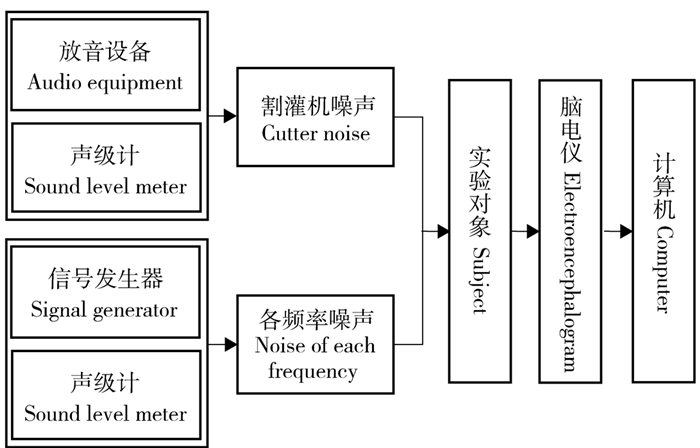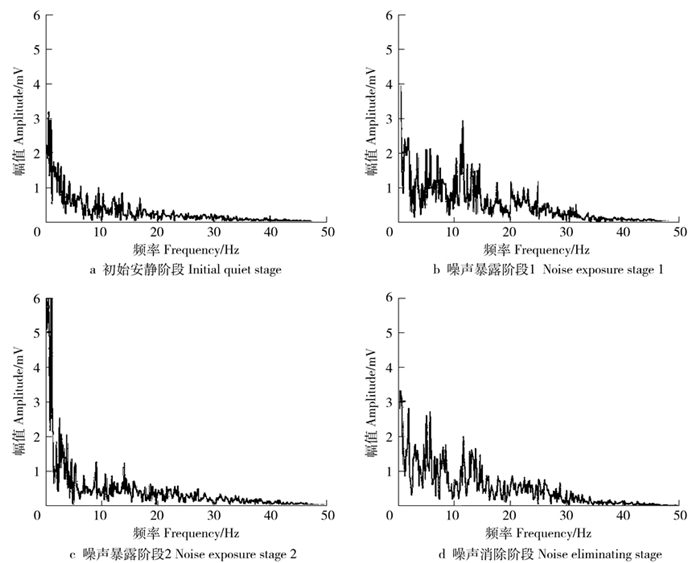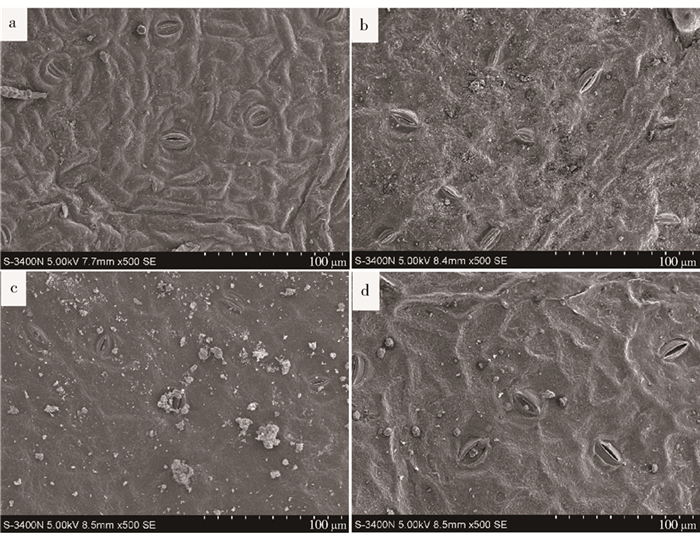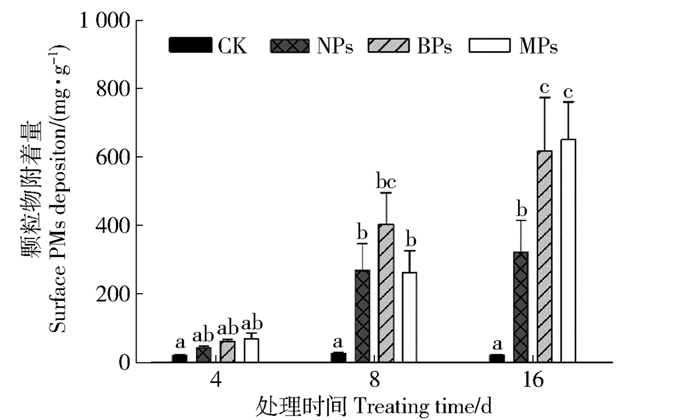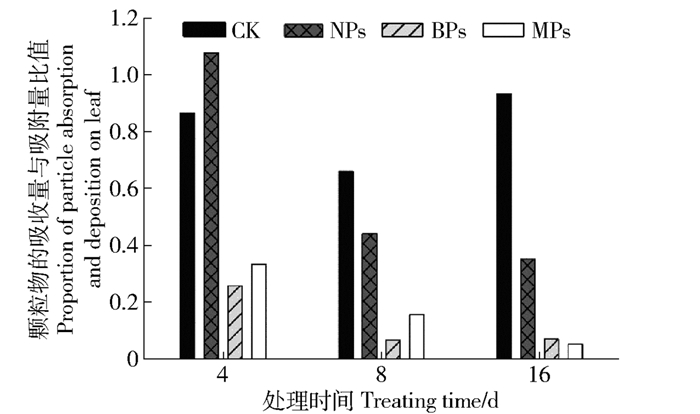Deposition and absorption capacity of Populus deltoides × P. nigra to different size zinc oxide aerosol
-
摘要: 为揭示植物叶片对大气颗粒物的滞纳效应,本研究首次采用氧化锌(ZnO)纳米颗粒物模拟PM2.5等颗粒物在欧美杨DN-2叶片表面的沉降、附着和滞留过程,利用水洗法和电感耦合等离子体质谱(ICP-MS)分别测定叶片表面和组织内的ZnO含量,通过扫描电子显微镜对叶表形貌进行观察和附着颗粒物数量统计,定量研究欧美杨对不同粒径颗粒物的吸附和吸收能力及其光合生理的响应特征。结果表明:粒径约为30 nm(NPs)、100 nm(BPs)和1 μm(MPs)的3种ZnO气溶胶处理16 d后,欧美杨叶片表面对MPs的吸附质量最大,高达653.03 mg/g,显著高于NPs。而通过Image J软件统计叶表面颗粒物的数量发现,NPs处理下叶面附着颗粒物数量最多,BPs次之,MPs最少,说明颗粒物的粒径越小,分布在叶片表面的数量越多,但其在叶面附着质量较低。此外,通过对植物叶表形貌观察发现,颗粒物对气孔和角质层产生了负面影响,气孔轮廓不清晰,角质层皱折不规则。在模拟颗粒物环境中,欧美杨对粒径小于1 μm颗粒物均有一定量的吸收。与吸附质量不同,欧美杨叶片对NPs的吸收量显著高于BPs和MPs,在处理16 d后高达1.17 mg/g,分别是BPs和MPs的2.59和2.89倍,这表明粒径越小的颗粒物越容易被植物吸收进入体内。NPs、BPs和MPs处理16 d后,欧美杨叶片净光合速率(Pn)分别降低了22%、44%和19%,这是由气孔和非气孔因素共同导致的。Abstract: To investigate the deposition and absorption of particulate matters on leaves, this study firstly uses the zinc oxide (ZnO) nanoparticles to simulate sedimentation, attachment and retention of fine particulate matter (PM2.5) on Populus deltoides × P. nigra leaves. The contents of ZnO on the leaf surface and in the leaf tissue were quantitatively determined by water-washing and inductively coupled plasma mass spectrometry (ICP-MS), respectively. Furthermore, ZnO particle number on the leaf surface and its microstructure were analyzed by an scan electron microscope (SEM)and the response characteristics of photosynthetic physiology was also investigated by the Li-COR 6400 portable photosynthesis system. The results showed that ZnO particles could be adhered by leaves which were treated with NPs (particles with a mean diameter of 30 nm), BPs (particles with a mean diameter of 100 nm) or MPs (particles with a mean diameter of 1 μm). The deposition capacity of Populus deltoides × P. nigra to different particles was mainly analyzed from two aspects of total quality and total particle number. The mass concentration of MPs on leaf surface was the highest after treated for 16 days, reaching 653.03 mg/g, which was significantly higher than NPs. Analyzed by Image J software, the number of particles on the foliar surface was the highest under NPs treatment, followed by BPs and MPs, indicating that the smaller the size of the particles were, the larger the number of particles distributed on the surface of the leaves, while the weight of the smaller particles was relatively lower. Moreover, P. deltoides × P. nigra could uptake particle less than 1 μm. Compared with weight of deposition, the uptake of NPs by leaves was higher, reaching 1.17 mg/g after 16 day treatment, which was 2.59 and 2.89 times of BPs and MPs, respectively. This indicated that the smaller size of particle was easily absorbed by plants. Phytotoxicity was tested for plants exposed to different size of ZnO aerosol. Leaf surface microstructure had obvious change, stomata was often filled with ZnO particles or was also clogged and injured cells, and slightly disturbed striations were also visible in the ZnO-treated leaves. Moreover, acute phytotoxicity was also observed in photosynthetic. After 16 days treatment of NPs, BPs and MPs, net photosynthetic rate (Pn) was reduced by 22%, 44% and 19%, respectively, which was caused by stomatal and non-stomatal factors.
-
Keywords:
- Populus deltoides × P. nigra /
- PM2.5 /
- ZnO particle /
- absorption /
- deposition /
- physiological characteristics
-
噪声会增加劳动者的生理和心理负荷,引起工作能力下降,甚至能够导致职业听力损失和心率变异[1-3]。2012年我国实施的GBZ/T229.4—2012《工作场所职业病危害作业分级第4部分:噪声》[4]规定了噪声危害级别,目的是保护劳动者不受过度噪声的干扰或伤害。园林工人用来割除杂草、藤蔓的割灌机在作业时会产生较大的噪声。叶仲基等[5]对台湾割灌作业中使用打草绳和2齿刀片产生的噪声进行了数据调查;莫秋云等[6-7]基于人体脑波和心率变异对噪声综合评价方法进行了研究;Hinchcliffe[8]研究了噪声对听力、心率以及疲劳的影响;GB/T 5390—2013规定了以内燃机为动力的便携式手持操作林业和园林机械A计权声功率级和耳旁噪声的测定方法[9]。但是,园林工人在实际操作割灌机时,会根据不同的现场地形和切割对象变化来选择适当的刀具进行作业,由于机器老化、地形差异、切割刀具和对象的变化,割灌机作业产生的噪声与企业检测结果会有明显差异。在园林作业现场,对园林工人每个工作日操作割灌机作业的噪声暴露剂量和噪声频谱进行实际调查和记录,分析噪声对园林工人脑电波的影响,对于提高园林工人的职业安全,减少职业病的发生和提升割灌机具的设计生产水平具有现实意义。
1. 材料与方法
1.1 割灌作业现场噪声检测实验
1.1.1 实验对象和设备
选取18名年龄在40~50岁的男性园林工人, 平均身高174 cm,平均体重65.2 kg,受试者均能够熟练操作割灌机,身体健康无疾病,实验前一天无反常情绪影响,休息充分。
背负式割灌机选用国内使用率较高的BG140型四冲程背负式割灌机,净质量9.5 kg,排量37.7 mL,工作杆长度1 330 mm;侧挂式割灌机选用国内使用率较高的CG140型四冲程侧挂式割灌机,排量37.7 mL,净质量8.5 kg,工作杆长度1 330 mm,燃油为93#汽油,刀具选用圆形尼龙打草绳(直径2.4 mm、长度150 mm)、2齿锰钢菱形刀片(长305 mm、宽90 mm、厚2 mm)、4齿锰钢刀片(直径255 mm、厚2 mm)、40齿锰钢刀片(直径255 mm、厚2 mm)。割灌机均已正常使用1年以上,非出厂新机。噪声声级计选用台湾泰仕牌TES-1355型噪音计声级计。音频分析仪选用恒升HS5671A型噪声频谱分析仪,符合IEC1260和GB/T3241—1998对倍频程滤波器和1/3倍频程滤波器的要求。
1.1.2 实验方法
在园林作业现场,采用对园林工人实际测量的方式进行实验检测,并进行噪声采集。实验于2015年6月在哈尔滨某生态公园进行,分为噪声声级检测和噪声频谱检测两部分,并按照割灌机种类、刀具型号进行分类。根据调查,园林工人在作业中针对现场地形和切割对象的变化,常用刀具的对应情况如表 1所示。
表 1 园林工人常用刀具与作业环境对照Table 1. Comparison of common tools and operating environment for garden workers打草绳
Trimmer line2齿刀片
Two-tooth cutting tool4齿刀片
Four-tooth cutting tool40齿刀片
Forty-tooth cutting tool地形
Terrain切割对象
Cutting object地形
Terrain切割对象
Cutting object地形
Terrain切割对象
Cutting object地形
Terrain切割对象
Cutting object背负式割灌机
Knapsack brush cutter起伏地面
Undulating ground高度≤300 mm低软嫩草
Low soft tender grass with height≤300 mm起伏地面
Undulating ground高度≤300 mm
多种类杂草Variety of weeds with height≤300 mm起伏地面
Undulating ground高度≥300 mm多种类高韧杂草
Variety of high tough weeds with height≥300 mm起伏地面
Undulating ground直径15~50 mm较坚硬灌木
Harder shrub with ϕ15-50 mm侧挂式割灌机
Shoulder-hanging brush cutter平整草坪
Smooth lawn高度≤300 mm低软嫩草
Low soft tender grass with height≤300 mm平整地面
Flat ground高度≤300 mm多种类杂草
Variety of weeds with height≤300 mm平整地面
Flat ground高度≥300 mm多种类高韧杂草
Variety of high tough weeds with height≥300 mm平整地面
Flat ground直径15~50 mm较坚硬灌木
Harder shrub with ϕ15-50 mm1) 噪声声级检测。将噪声声级计固定于割灌机作业人员腰间,再将麦克风固定于人员颈后(侧挂式割灌机为右侧)衣领处。门槛声压位准采用80 dB。噪声声级检测实验的目的是测量作业者整个工作日的耳旁噪声暴露声级和暴露剂量。在实验过程中,对作业时间、地点、检测时间、割灌机型式、割灌机型号、刀具型式、环境温湿度、草的长度、背景噪声、噪声声级计型号等项目内容进行记录,检测完毕后,对声级计检测的噪声剂量与8小时加权平均分贝数值进行记录。
2) 噪声频谱检测。根据GB10000—1988中国成年人人体尺寸国家标准[10],人耳距离地面高度约为1 500 mm,将音频分析仪固定于距离地面1 500 mm的支架上,实验测量时间为5 min,分析频率范围在100~6 000 hz,采用1/3倍频。噪声频谱检测实验的目的是调查割灌机作业时噪声的主要集中频率与频率的分布。对割灌机怠速空转(1 500~2 000 r/min)、低速作业(2 000~4 000 r/min)和高速作业(4 000~6 500 r/min)的噪声频谱分别进行检测记录,然后对结果进行对比分析。
1.2 人体脑电测试
1.2.1 实验对象和设备
选取18名年龄在40~50岁的男性园林工人, 平均身高174 cm,平均体重65.2 kg,受试者均能够熟练操作割灌机,身体健康无疾病,实验前一天无反常情绪影响,休息充分。。
脑电测试仪采用荷兰ANT Neuro公司生产的64通道无线脑电肌电系统(Ultra-Mobile EEG & EMG Recording Platform)。噪声声级计、音频分析仪同上文。
1.2.2 实验方法
脑电信号与人的精神状态有密切联系,且准确度高、客观性强,在疲劳检测领域有广泛应用。Berger把脑波分成α波、β波、θ波、δ波[11],在β波时人的注意力集中或精神紧张,脑电中的α波受到抑制或消失,部分人可出现θ波,而在精神放松时α波明显增强,但精神放松到一定阶段而出现倦意时,α波则渐渐解体,同时θ波活动增强。近年,国外研究资料[12-13]也表明:脑电θ波的变化与人的心理活动和情感变化密切相关。随着睡眠的加深,α波随之逐步消失,而且逐步被高振幅的慢波所代替,此时,在脑电图中以θ波或δ波为主。如果人处于昏迷状态时,脑电图将全部出现δ波。
本研究选取人体脑电作为噪声对人体生理及心理负荷影响的评价指标。将1.1割灌作业现场噪声检测实验中采集的噪声录音文件进行回放,为了充分考虑实际噪声和单频噪声对人体影响, 以便于对不同单频噪声的对比分析, 选择了两类噪声进行实验:1)现场噪声,工人使用割灌机不同刀具在低速和高速作业切割时的噪声,取平均值90 dB;2)不同频率下的单频噪声,频率与声级如表 2所示。实验时间为5 min,为了保证实验的可对比性,将实验时间分为初始安静阶段(60 s)、噪声暴露阶段1(90 s)、噪声暴露阶段2(90 s)和噪声消除阶段(60 s),之后根据脑电的频谱变化更准确地分析噪声对疲劳程度的影响。实验地点为东北林业大学人机工程实验室。实验系统框图如图 1所示。实验对象保持坐姿,对头皮酒精消毒后,涂抹脑电传导胶,佩戴脑电帽,如图 2所示。闭目,与噪声源距离0.2 m,开始实验,实验过程中实验对象只受有无噪声变化的影响,其他环境因素不变。
表 2 不同频率下的单频噪声对照Table 2. Single frequency noise control at different frequencies频率
Frequency/Hz800 1 200 2 000 3 150 4 000 声级Noise level/dB 80 80 80 80 80 85 85 85 85 85 90 90 90 90 90 2. 结果与分析
2.1 噪声声级
对18名实验对象进行5个工作日的噪声监测调查,以每人每工作日的测量数据为一组,共计90组数据,其中背负式割灌机数据51组,侧挂式割灌机数据39组。对每组数据进行统计计算,结果如表 3所示。
表 3 割灌机噪声检测实验结果Table 3. Experimental results of noise level detection in brush cutters打草绳
Trimmer line2齿刀片
Two-tooth cutting tool4齿刀片
Four-tooth cutting tool40齿刀片
Forty-tooth cutting tool噪声剂量
Noise dose/%8小时加权平均分贝
8-hour time-weighted average decibel/dB噪声剂量
Noise dose/%8小时加权平均分贝
8-hour time-weighted average decibel/dB噪声剂量
Noise dose/%8小时加权平均分贝
8-hour time-weighted average decibel/dB噪声剂量
Noise dose/%8小时加权平均分贝
8-hour time-weighted average decibel/dB背负式割灌机Knapsack brush cutter 44.90 84.40 69.55 88.28 75.11 90.40 77.76 92.37 侧挂式割灌机Shoulder-hanging brush cutter 41.66 82.13 50.52 85.03 64.80 86.09 70.00 90.75 由表 3可见,背负式割灌机和侧挂式割灌机在使用不同刀具进行作业时产生的噪声剂量不同。背负式割灌机在使用打草绳、2齿刀片、4齿刀片和40齿刀片作业时,其8小时加权平均分贝分别为84.40<88.28<90.4<92.37 dB;侧挂式割灌机分别为82.13<85.03<86.09<90.75 dB。在使用相同刀具时,背负式割灌机作业人员的8小时加权平均分贝值都高于使用侧挂式割灌机的。
在噪声声级检测实验得出的90组数据中,共有54组数据的耳旁噪声8小时加权平均分贝超过85 dB,达到GBZ/T229.4—2012《工作场所职业病危害作业分级第4部分:噪声》[4]规定的轻度噪声危害级别;共有32组数据超过90 dB,达到中度噪声危害级别。
2.2 噪声频谱
对51组背负式割灌机和39组侧挂式割灌机使用不同刀具在怠速空转、低速作业和高速作业状态中的声级和频率分别进行检测记录,对每组数据进行统计计算,结果如表 4所示。
表 4 割灌机噪声频谱检测实验结果Table 4. Experimental results of noise spectrum detection for brush cutter打草绳
Trimmer line2齿刀片
Two-tooth cutting tool4齿刀片
Four-tooth cutting tool40齿刀片
Forty-tooth cutting tool声级
Noise level/dB频率
Frequency/Hz声级
Noise level/dB频率
Frequency/Hz声级
Noise level/dB频率
Frequency/Hz声级
Noise level/dB频率
Frequency/Hz背负式割灌机
Knapsack brush cutter怠速
Idle speed74.58 800 75.73 630~2 000 75.83 630~2 000 76.96 630~2 000 低速
Low speed80.43 800 81.52 800~2 000 84.2 800~2 000 85.81 2 000 高速
High speed92.68 800~4 000 88.05 500~2 000 90.77 500~2 000 91.93 500~2 000 侧挂式割灌机
Shoulder-hanging brush cutter怠速
Idle speed77.32 500~2 000 77.51 500~800 78.33 2 000 77.63 2 000 低速
Low speed84.72 800~3 150 84.16 800 86.41 2 000 89.31 2 000 高速
High speed92.66 2 500~4 000 94.83 2 500~4 000 90.76 4 000 93.01 4 000 由噪声频谱检测实验结果可见:在怠速空转时,背负式割灌机产生的噪声频谱数据集中在630~2 000 hz,声级数据集中在74.58~76.96 dB;侧挂式割灌机产生的噪声频谱数据集中在500~2 000 hz,声级数据集中在77.32~78.33 dB。检测数据符合GBZT229.4—2012规定,但是作业人员在割草时不可能使用怠速操作。
在低速作业时,背负式割灌机产生的噪声频谱数据集中在800~2 000 hz,声级数据集中在80.43~85.81 dB;侧挂式割灌机产生的噪声频谱数据集中在800~3 150 hz,声级数据集中在84.16~89.31 dB。与怠速空转时相比,噪声频谱数据和声级数据都有所增加,有多组声级数据超过了GBZT229.4—2012规定的轻度危害值85 dB,特别是在使用40齿刀片对较坚硬的灌木进行修剪时,声级数据更是达到了89.31 dB,接近了中度危害的临界值90 dB。
在高速作业时,背负式割灌机产生的噪声频谱数据集中在500~4 000 hz,声级数据集中在88.05~92.68 dB;侧挂式割灌机产生的噪声频谱数据集中在2 500~4 000 hz,声级数据位于90.76~94.83 dB。与怠速空转和低速作业相比较,高速作业时的噪声频谱数据和声级数据都有所增加,侧挂式割灌机的声级数据最大值达到了94.83 dB,已接近重度危害的临界值95 dB。
根据GBZT229.4—2012规定的分级管理原则,在目前的作业条件下,很可能对劳动者的听力产生不良影响,必须采取噪声控制措施,减少作业者噪声暴露时间,作业时佩戴有效的耳塞、耳罩等个人防护用品,以避免噪声危害。
2.3 割灌机作业噪声对园林工人脑波的影响
图 3截取了一例实验对象不同状态下在电极O1处的脑电数据样本,每个样本时间为6 s,共3 000个数据点。
对图 3中的脑电进行快速傅立叶变换(FFT), 得到其相应的频谱图(图 4)。
有研究证明:脑电α波和β波频带的平均功率谱密度比值R可作为衡量作业疲劳度的脑电特征量[14]。设信号在频带h的平均功率谱密度G(h)为:
G(h)=∫fufdp(f)dffu−fd (1) 式中:fu为频带h的上限,Hz;fd为h频带的下限,Hz;p(f)为信号的功率谱密度,W/Hz。令:
R=G(h1)G(h2) (2) 式中:h1为α波频带;h2为β波频带。
表 5为18个实验对象在初始安静阶段、噪声暴露阶段1、噪声暴露阶段2和噪声消除阶段时O1电极处的脑电α波频带(10~13 hz)和β波频带(18~22 hz)的R值统计数据。
表 5 18名实验对象的脑电R值Table 5. Electroencephalogram R value of 18 test subjects初始安静阶段
Initial quiet stage噪声暴露阶段1
Noise exposure phase 1噪声暴露阶段2
Noise exposure phase 2噪声消除阶段
Noise eliminating phase平均值Average 1.27 3.69 3.15 1.73 标准差Standard deviation 0.09 0.50 0.30 0.15 在噪声暴露阶段1,脑电α波和β波的R平均值为3.69,对比初始安静阶段,R值有明显提高;在噪声暴露阶段2,R平均值为3.15,相比噪声暴露阶段1,共有9例实验对象的R值有所回落,其原因可能是生理对噪声有所适应,情绪紧张度下降;在噪声消除阶段,实验对象的R值迅速下降,说明脑电对噪声反应敏感,减少噪声即可降低噪声对脑波反映出的心理负荷影响。
3. 结论与讨论
本研究在园林作业现场,对园林工人每个工作日操作割灌机作业的噪声暴露剂量和噪声频谱进行了实际测量和记录;并根据已获得的割灌机作业现场噪声录音文件,对18名实验对象进行了脑电测量实验,分析了噪声对园林工人脑电的影响,强调了被忽略的噪声影响劳动安全的心理负荷问题。具体结论如下:
1) 在园林工人操作割灌机进行绿化作业时,有半数以上操作者的耳旁噪声暴露剂量处于超标状态,达到了轻度或中度噪声危害等级。割灌机低速作业产生的噪声已达轻度危害等级,高速作业产生的噪声频率已达到中度危害等级。
2) 园林绿化部门必须加大对割灌机的设计研究投入,减少割灌机本身的振动和噪声。根据噪声特性,选择适宜的防护用具,阻止噪声传播,减少噪声对作业者产生的影响。
3) 由人体脑电实验得出的数据样本可知:割灌机作业产生的噪声对人体脑波变化的影响差异性显著,脑电特征量或可作为衡量噪声负荷与作业疲劳度的影响因子。
4) 脑电信号具有易干扰、复杂性的特点,本实验是以模拟噪声现场环境数据为基础的,是否还有预测效果更好的脑电特征量指标,尚需进一步的对比分析,且需要在真实工况中进一步验证结论的有效性。
-
表 1 欧美杨叶片表面吸附颗粒物的粒径分布
Table 1 Size distribution of the particles on the leaf surface of P. deltoides × P. nigra
颗粒物粒径
Particle size/μmNPs BPs MPs 4 d 16 d 增长率
Increasing rate4 d 16 d 增长率
Increasing rate4 d 16 d 增长率
Increasing rate0.1~0.5 418.35±68.62 737.28±125.39 1.76 290.88±63.15 534.52±196.32 1.83 45.03±21.32 143.2±63.59 3.18 0.5~1.0 66.72±15.30 176.49±23.65 2.63 60.55±23.01 182±72.30 3.01 115.63±32.56 433.23±145.20 3.74 1.0~2.5 22.23±6.33 151.68±69.35 6.8 54.83±20.36 36.12±12.68 0.65 51.52±15.9 128.1±8.66 2.51 >2.5 2.03±0.32 2.86±0.63 1.43 5.6±0.95 2.60±0.32 0.464 2.84±0.67 4.25±0.32 1.40 总个数
Total number509.3 1 067.82 2.09 411.87 755.24 1.83 224.99 708.56 3.14 注:NPs为粒径约30 nm的颗粒物; BPs为粒径约100 nm的颗粒物; MPs为粒径约1.0 μm的颗粒物。下同。数值为12个视野的平均值±SD,500×。Notes:NPs, particle average diameter about 30 nm; BPs, particle average diameter about 100 nm; MPs, particle average diameter about 1.0 μm. Same as below. Value was an average of 12 fields of view ±SD, 500×. -
[1] LI Z Q, NIU F, FAN J W, et al. Long-term impacts of aerosols on the vertical development of clouds and precipitation[J]. Nature Geoscience, 2011, 4(12): 888-894. doi: 10.1038/ngeo1313
[2] POSFAI M, BUSECK P R. Nature and climate effects of individual tropospheric aerosol particles[J]. Annual Review of Earth and Planetary Sciences, 2010, 38(1): 17-43. doi: 10.1146/annurev.earth.031208.100032
[3] WANG Y, WAN Q, MENG W, et al. Long-term impacts of aerosols on precipitation and lightning over the pearl river delta megacity area in China[J]. Atmospheric Chemistry and Physics, 2011, 11(23): 12421-12436. doi: 10.5194/acp-11-12421-2011
[4] DING X, WANG M, CHU H, et al. Global gene expression profiling of human bronchial epithelial cells exposed to airborne fine particulate matter collected from Wuhan, China[J]. Toxicology Letters, 2014, 228(1): 25-33. doi: 10.1016/j.toxlet.2014.04.010
[5] YU H, KAUFMAN Y J, CHIN M, et al. A review of measurement-based assessments of the aerosol direct radiative effect and forcing[J]. Atmospheric Chemistry and Physics, 2006, 6: 613-666. doi: 10.5194/acp-6-613-2006
[6] MORGENSTERN V, ZUTAVERN A, CYRYS J, et al. Respiratory health and individual estimated exposure to traffic-related air pollutants in a cohort of young children[J]. Occupational and Environmental Medicine, 2007, 64(1): 8-16. http://d.old.wanfangdata.com.cn/OAPaper/oai_pubmedcentral.nih.gov_2092590
[7] ARNOLD C. Disease burdens associated with PM2.5 exposure how a new model provided global estimates[J]. Environmental Health Perspectives, 2014, 122(4): 111-116. http://www.wanfangdata.com.cn/details/detail.do?_type=perio&id=94e90f9ebb63eb6ba27225396c6b8b9c
[8] NGUYEN T, YU X, ZHANG Z, et al. Relationship between types of urban forest and PM2. 5 capture at three growth stages of leaves[J]. Journal of Environmental Sciences-China, 2015, 27: 33-41. doi: 10.1016/j.jes.2014.04.019
[9] 刘庆倩, 石婕, 安海龙, 等.应用15N示踪研究欧美杨对PM2.5无机成分NH4+和NO3-的吸收与分配[J].生态学报, 2015, 35(19): 1-10. http://www.wanfangdata.com.cn/details/detail.do?_type=perio&id=stxb201519032 LIU Q Q, SHI J, AN H L, et al. Absorption and distribution of NH4+ and NO3- in PM2.5 in Populus euramericana Neva. by 15N Tracing[J]. Acta Ecologica Sinica, 2015, 35(19): 1-10. http://www.wanfangdata.com.cn/details/detail.do?_type=perio&id=stxb201519032
[10] HU Y, FERNANDEZ V, MA L, et al. Nitrate transporters in leaves and their potential roles in foliar uptake of nitrogen dioxide[J]. Frontiers in Plant Science, 2014, 5: 360. http://www.wanfangdata.com.cn/details/detail.do?_type=perio&id=Doaj000004618335
[11] 安海龙, 刘庆倩, 曹学慧, 等.不同PM2.5污染区常见树种叶片对PAHs的吸收特征分析[J].北京林业大学学报, 2016, 38(1): 59-66. doi: 10.13332/j.1000--1522.20150164 AN H L, LIU Q Q, CAO X H, et al. Absorption features of PAHs in leaves of common tree species at different PM2.5 polluted places[J]. Journal of Beijing Forestry University, 2016, 38(1): 59-66. doi: 10.13332/j.1000--1522.20150164
[12] 曹学慧, 安海龙, 刘庆倩, 等.欧美杨对PM2.5中重金属铅的吸附、吸收及适应性变化[J].生态学杂志, 2015, 34(12): 1-9. http://d.old.wanfangdata.com.cn/Periodical/stxzz201512015 CAO X H, AN H L, LIU Q Q, et al. Adhesion and absorption of Pb in PM2.5 and adaptative changes in Populous euramericana[J]. Chinese Journal of Ecology, 2015, 34(12): 1-9. http://d.old.wanfangdata.com.cn/Periodical/stxzz201512015
[13] 谢滨泽, 王会霞, 杨佳, 等.北京常见阔叶绿化植物滞留PM2.5能力与叶面微结构的关系[J].西北植物学报, 2014, 34(12): 2432-2438. doi: 10.7606/j.issn.1000-4025.2014.12.2432 XIE B Z, WANG H X, YANG J, et al. Retention capability of PM2.5 and explanation by leaf surface microstructure of commom bread leaves plant species in Beijing[J]. Acta Botanica Borealioccidentalia Sinica, 2014, 34(12): 2432-2438. doi: 10.7606/j.issn.1000-4025.2014.12.2432
[14] SONG Y S, MAHER B A, LI F, et al. Particulate matter deposited on leaf of five evergreen species in Beijing, China: source identification and size distribution[J]. Atmospheric Environment, 2015, 105: 53-60. doi: 10.1016/j.atmosenv.2015.01.032
[15] NOWAK D J, HIRABAYASHI S, BODINE A, et al. Modeled PM2.5 removal by trees in ten USA cities and associated health effects[J]. Environmental Pollution, 2013, 178: 395-402. doi: 10.1016/j.envpol.2013.03.050
[16] HWANG H J, YOOK S J, AHN K H. Experimental investigation of submicron and ultrafine soot particle removal by tree leaves[J]. Atmospheric Environment, 2011, 45(38): 6987-6994. doi: 10.1016/j.atmosenv.2011.09.019
[17] 梁丹, 王彬, 王云琦, 等.北京市典型绿化灌木阻滞吸附PM2.5能力研究[J].环境科学, 2014, 35(9): 3605-3611. http://d.old.wanfangdata.com.cn/Periodical/hjkx201409055 LIANG D, WANG B, WANG Y Q, et al. Ability of typical greenery shrubs of Beijing to adsorb and arrest PM2.5[J]. Environmental Science, 2014, 35(9): 3605-3611. http://d.old.wanfangdata.com.cn/Periodical/hjkx201409055
[18] GUO S, HU M, ZAMORA M L, et al. Elucidating severe urban haze formation in China[J]. Proceedings of the National Academy of Sciences of the United States of America, 2014, 111(49): 17373-17378. doi: 10.1073/pnas.1419604111
[19] MIRALLES P, CHURCH T L, HARRIS A T. Toxicity, uptake, and translocation of engineered nanomaterials in vascular plants[J]. Environmental Science and Technology, 2012, 46(17): 9224-9239. doi: 10.1021/es202995d
[20] 王晴晴, 马永亮, 谭吉华, 等.北京市冬季PM2.5中水溶性重金属污染特征[J].中国环境科学, 2014, 34(9): 2204-2210. http://d.old.wanfangdata.com.cn/Periodical/zghjkx201409006 WANG Q Q, MA Y L, TAN J H, et al. Characterization of water-soluble heavy metals of PM2.5 during winter in Beijing[J]. China Environmental Science, 2014, 34(9): 2204-2210. http://d.old.wanfangdata.com.cn/Periodical/zghjkx201409006
[21] 于扬, 岑况, Stefan Norra, 等.北京市PM2.5中主要重金属元素污染特征及季节变化分析[J].现代地质, 2012, 26(5): 975-982. doi: 10.3969/j.issn.1000-8527.2012.05.018 YU Y, CEN K, NORRA S, et al. Concentration characteristics and seasonal trend of main heavy metal elements of PM2.5 in Beijing[J]. Geoscience, 2012, 26(5): 975-982. doi: 10.3969/j.issn.1000-8527.2012.05.018
[22] HONG J, PERALTAVIDEA J R, RICO C, et al. Evidence of translocation and physiological impacts of foliar applied CeO2 nanoparticles on cucumber (Cucumis sativus) plants[J]. Environment Science and Technology, 2014, 48(8): 4376-4385. doi: 10.1021/es404931g
[23] OTTELE M, BOHEMEN H D V, FRAAIJ A L A. Quantifying the deposition of particulate matter on climber vegetation on living walls[J]. Ecological Engineering, 2010, 36(2): 154-162. doi: 10.1016/j.ecoleng.2009.02.007
[24] JANHALL S. Review on urban vegetation and particle air pollution deposition and dispersion[J]. Atmospheric Environment, 2015, 105: 130-137. doi: 10.1016/j.atmosenv.2015.01.052
[25] 王晓磊, 王成.城市森林调控空气颗粒物功能研究进展[J].生态学报, 2014, 34(8): 1910-1921. http://d.old.wanfangdata.com.cn/Periodical/stxb201408002 WANG X L, WANG C. Research status and prospects on functions of urban forests in regulating the air particulate matter[J]. Acta Ecologica Sinica, 2014, 34(8): 1910-1921. http://d.old.wanfangdata.com.cn/Periodical/stxb201408002
[26] 杨佳, 王会霞, 谢滨泽, 等.北京9个树种叶片滞尘量及叶面微形态解释[J].环境科学研究, 2015, 28(3): 384-392. http://www.wanfangdata.com.cn/details/detail.do?_type=perio&id=664064541 YANG J, WANG H X, XIE Z B, et al. Accumulation of particulate matter on leaves of nine urban greening plant species with different micromorphological structures in Beijing[J]. Research of Environmental Sciences, 2015, 28(3): 384-392. http://www.wanfangdata.com.cn/details/detail.do?_type=perio&id=664064541
[27] 陈波, 鲁绍伟, 李少宁, 等.北京城市森林不同天气状况下PM2.5浓度变化[J].生态学报, 2016, 36(5): 1391-1399. http://d.old.wanfangdata.com.cn/Periodical/stxb201605023 CHEN B, LU S W, LI S N, et al. Dynamic analysis of PM2.5 concentration in urban forests in Beijing for various weather conditions[J]. Acta Ecologica Sinica, 2016, 36(5): 1391-1399. http://d.old.wanfangdata.com.cn/Periodical/stxb201605023
[28] 戴斯迪, 马克明, 宝乐, 等.北京城区公园及其邻近道路国槐叶面尘分布与重金属污染特征[J].环境科学学报, 2013, 33(1): 154-162. http://d.old.wanfangdata.com.cn/Periodical/hjkxxb201301022 DAI S D, MA K M, BAO L, et al. Distribution of particle matters and contamination of heavy metals in the foliar dust of Sophora japonica in parks and their neighboring roads in Beijing[J]. Acta Scientiae Circumstantiae, 2013, 33(1): 154-162. http://d.old.wanfangdata.com.cn/Periodical/hjkxxb201301022
[29] 杨柳, 吴烨, 宋少洁, 等.不同交通状况下道路边大气颗粒物数浓度粒径分布特征[J].环境科学, 2012, 33(3): 694-700. http://d.old.wanfangdata.com.cn/Periodical/hjkx201203004 YANG L, WU Y, SONG S J, et al. Particle number size distribution near a major road with different traffic conditions[J]. Environmental Science, 2012, 33(3): 694-700. http://d.old.wanfangdata.com.cn/Periodical/hjkx201203004
[30] 赵松婷, 李新宇, 李延明.园林植物滞留不同粒径大气颗粒物的特征及规律[J].生态环境学报, 2014, 23(2): 271-276. doi: 10.3969/j.issn.1674-5906.2014.02.014 ZHAO S T, LI X Y, LI Y M. The characteristics of deposition of airborne particulate matters with different size on certain plants[J]. Ecology and Environmental Sciences, 2014, 23(2): 271-276. doi: 10.3969/j.issn.1674-5906.2014.02.014
[31] TERZAGHI E, WILD E, ZACCHELLO G, et al. Forest filter effect: role of leaves in capturing/releasing air particulate matter and its associated PAHs[J]. Atmospheric Environment, 2013, 74(2): 378-384. https://www.sciencedirect.com/science/article/pii/S1352231013002586
[32] TEPER E. Dust-particle migration around flotation tailings ponds: pine needles as passive samplers[J]. Environmental Monitoring and Assessment, 2009, 154(1-4): 383-391. doi: 10.1007/s10661-008-0405-4
[33] 王慧, 刘庆倩, 安海龙, 等.城市环境中毛白杨和油松叶片表面颗粒污染物的观察[J].北京林业大学学报, 2016, 38(8): 28-35. doi: 10.13332/j.1000-1522.20160065 WANG H, LIU Q Q, AN H L, et al. Observation of particulate pollutants retained on Populus tomentosa and Pinus tabulaeformis leaves in urban environment[J]. Journal of Beijing Forestry University, 2016, 38(8): 28-35. doi: 10.13332/j.1000-1522.20160065
[34] 史军娜, 张罡, 安海龙, 等.北京市16种树木吸附大气颗粒物的差异及颗粒物研究[J].北京林业大学学报, 2016, 38(12): 84-91. doi: 10.13332/j.1000-1522.20160053 SHI J N, ZHANG G, AN H L, et al. Differences in atmospheric particle accumulation on leaf surface in sixteen tree species in Beijing and characteristics of particles[J]. Journal of Beijing Forestry University, 2016, 38(12): 84-91. doi: 10.13332/j.1000-1522.20160053
[35] EICHERT T, KURTZ A, STEINER U, et al. Size exclusion limits and lateral heterogeneity of the stomatal foliar uptake pathway for aqueous solutes and water-suspended nanoparticles[J]. Physiologia Plantarum, 2008, 134(1): 151-160. doi: 10.1111/j.1399-3054.2008.01135.x
[36] XIONG T T, LEVEQUE T, AUSTRUY A, et al. Foliar uptake and metal(loid) bioaccessibility in vegetables exposed to particulate matter[J]. Environmental Geochemistry and Health, 2014, 36(5): 897-909. doi: 10.1007/s10653-014-9607-6
[37] 陈世宝, 孙聪, 魏威, 等.根细胞壁及其组分差异对植物吸附、转运Zn的影响[J].中国环境科学, 2012, 32(9): 1670-1676. doi: 10.3969/j.issn.1000-6923.2012.09.019 CHEN S B, SUN C, WEI W, et al. Difference in cell wall components of roots and its effect on the transfer factor of Zn by plant species[J]. China Environmental Science, 2012, 32(9): 1670-1676. doi: 10.3969/j.issn.1000-6923.2012.09.019
[38] PRAJAPATI S K, TRIPATHI B D. Seasonal variation of leaf dust accumulation and pigment content in plant species exposed to urban particulates pollution[J]. Journal of Environmental Quality, 2008, 37(3): 865-870. doi: 10.2134/jeq2006.0511
[39] FERNANDEZ V, EICHERT T. Uptake of hydrophilic solutes through plant leaves: current state of knowledge and perspectives of foliar fertilization[J]. Critical Reviews in Plant Sciences, 2009, 28(1): 36-68. doi: 10.1080/07352680902743069?journalCode=bpts20
[40] 李威, 黄进, 李其昌, 等.纳米颗粒对植物光合作用影响机制的研究[J].生物学杂志, 2015(5): 63-66. doi: 10.3969/j.issn.2095-1736.2015.05.063 LI W, HUANG J, LI Q C, et al. Effect of nanoparticles on plant photosynthesis mechanism[J]. Journal of Biology, 2015(5): 63-66. doi: 10.3969/j.issn.2095-1736.2015.05.063
[41] 许大全.光合作用气孔限制分析中的一些问题[J].植物生理学报, 1997, 33(4): 241-244. doi: 10.1063-1.1913612/ XU D Q. Some problem in stomatal limitation analysis of photosynthesis[J]. Plant Physiology Communication, 1997, 33(4): 241-244. doi: 10.1063-1.1913612/
[42] 宋丽莉, 赵华强, 朱小倩, 等.高温胁迫对水稻光合作用和叶绿素荧光特性的影响[J].安徽农业科学, 2011, 39(22): 13348-13353. doi: 10.3969/j.issn.0517-6611.2011.22.035 SONG L L, ZHAO H Q, ZHU X Q, et al. Effect of high temperature stress on photosynthesis and chlorophyll fluorescence of rice[J]. Journal of Anhui Agriculture Science, 2011, 39(22): 13348-13353. doi: 10.3969/j.issn.0517-6611.2011.22.035
[43] 裴斌, 张光灿, 张淑勇, 等.土壤干旱胁迫对沙棘叶片光合作用和抗氧化酶活性的影响[J].生态学报, 2013, 33(5): 1386-1396. http://d.old.wanfangdata.com.cn/Periodical/stxb201305006 PEI B, ZHANG G C, ZHANG S Y, et al. Effects of soil drought stress on photosynthetic characteristics and antioxidant enzyme activities in Hippophae rhamnoides seedings[J]. Acta Ecologica Sinica, 2013, 33(5): 1386-1396. http://d.old.wanfangdata.com.cn/Periodical/stxb201305006
-
期刊类型引用(8)
1. 鹿林,张程凯,张慧. 自橡子壳中提取橡子壳棕色素的实验研究. 中国食品添加剂. 2024(10): 179-186 .  百度学术
百度学术
2. 靳子旋,张岩岩,杜黔运,徐静,赵余庆. 橡子化学成分及药理作用的研究进展. 中草药. 2023(24): 8301-8308 .  百度学术
百度学术
3. 翟淑红,曹洪坤,余诗琴,朱斯豪. 红菜苔多酚超声提取工艺优化及其抗氧化活性研究. 农产品加工. 2023(22): 49-52+56 .  百度学术
百度学术
4. 张博,李德海,王泽童,王楚雅,王怡雪. 橡子壳主要成分的生理功能及开发利用研究. 食品工业科技. 2022(07): 393-399 .  百度学术
百度学术
5. 王荣芳,张子言,李德海. 酶解法对蒙古栎实壳提取物活性成分及抗氧化活性的影响. 北京林业大学学报. 2022(05): 150-160 .  本站查看
本站查看
6. 豆佳媛,何志鹏,梁馨月,逯莉. 橡子中挥发油的提取及抗氧化性质研究进展. 广东化工. 2021(24): 55-56 .  百度学术
百度学术
7. 黄艳,傅新征,吴琳珊,李烨. 锥栗壳色素抗氧化活性研究. 食品科技. 2019(02): 274-280 .  百度学术
百度学术
8. 魏园园,侯盼盼,梁宗瑶,任维维,李珉梦,高鹏程,张建新,段旭昌. 栓皮栎橡子壳多酚的体外抗氧化与抑菌活性研究. 现代食品科技. 2019(09): 190-197+73 .  百度学术
百度学术
其他类型引用(8)



 下载:
下载:
